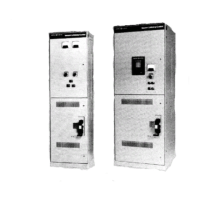CR194 Two-High Vacuum Limitamp@’ Control
Mechanical Interlocking
Vacuum Limitamp@ equipment is designed so that the
high-voltage contactor performs all normal load cur-
rent interrupting. The current limiting fuses generally
interrupt any fault currents.
NOTE:
The quick-make, quick-break isolation switch will not
interrupt any load orfault current.
A mechanical interference system is included with all
vacuum Limitamp@ controllers (mechanical interlock)
which prevents opening the isolation switch unless the
high-voltage contactor itself is demonstrated by mag-
net position to be already open. This is to insure that
the contactor has opened the power circuit and inter-
rupted the current before the isolation switch is oper-
ated. See Figure 13.
Figure 1.3. Contactor engagement paw1 for
mechanical interlock
WARNING:
The isolation switch handle should
never be forcibly operated. Its mechanical interfer-
ence interlock should be defeated only by knowl-
edgeable and qualified electrical maintenance per-
sonnel who have de-energized all power feeding
the controller.
WARNING:
There is no emergency condition that
can justify forcible operation of the isolation
isolation switch handle must be operated only with
The high-voltage doors on the CR194 two-high vacuum
Limitamp@ are mechanically interlocked with the isola-
tion switch handle which keeps the high voltage door
closed until the isolation switch is in the “OFF” position.
This is done to prevent exposure to high voltage. Other
high voltage doors in a diverse Limitamp@ lineup may
use either mechanical linkage interlocking or key type
interlocking to prevent access to high-voltage compo-
nents such as reactors, autotransformers, auxiliary trans-
formers, power factor capacitors, etc. In all cases of key
interlocking, it is very important and imperative to follow
the key lock operating scheme as described in the draw-
ings furnished with the equipment.
Auxiliary Enclosures
Many types of ‘enclosures are furnished in vacuum
Limitamp@ control lineups for various purposes. Some
are listed below:
l
Wound rotor secondary contactor and resistor
compartments
l
Bus transitions to switchgear, transformer,
bus duct, etc.
l
Cable entrance compartments
l
Synchronous exciter compartments
l
Starting reactor & autotransformer compartments
l
Relay & metering compartments
l
Non load-break switch compartments
l
IC1074 load-break switch compartments
The details for these enclosures will be included in the
drawings furnished with the equipment.
Dimensions
Vacuum Limitamp@ controllers are normally 30-inches
deep and go-inches high. The width of the CR194 two-
high vacuum Limitamp@ is 36 inches (40 inches op-
tional). See Figure 50 for dimension details.
Power Fuses
Bolted EJ-2 type current limiting power fuses are sup-
plied as standard with vacuum Limitamp@ controllers.
Clip-in fuses are available as an option to cover re-
quirements for EJ-1 type fuses, but the blown fuse
(anti-single phase) indication/trip functions are not
available with clip fuses, since this feature requires
precise alignment of the striker pin at the top of the
fuse with the operators. Coordination information for
EJ-2 type fuses is available in GES-5000, and for EJ-1
type fuses, GES-5002. Interrupting ratings are shown
in the “Ratings” section of this instruction.

